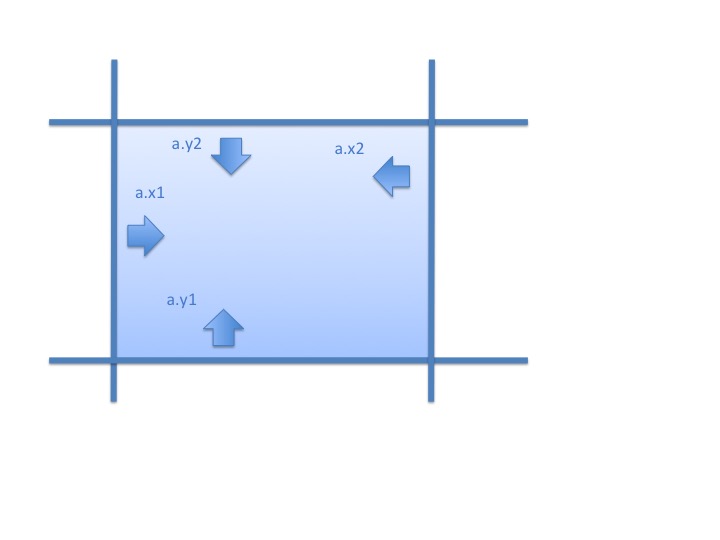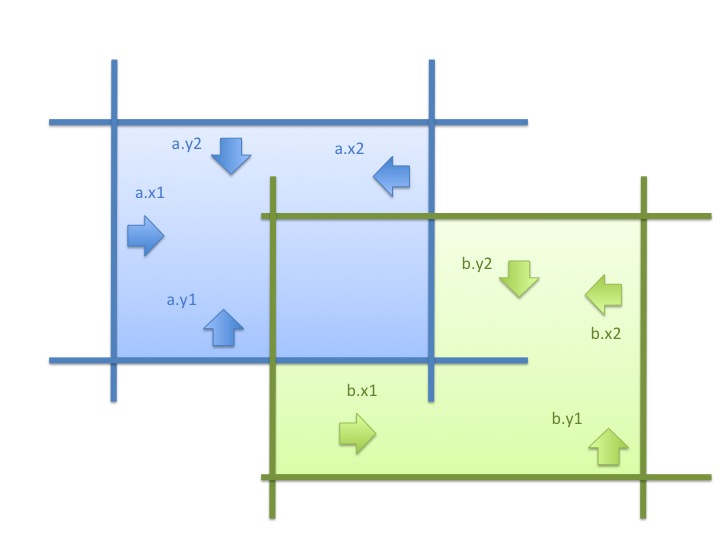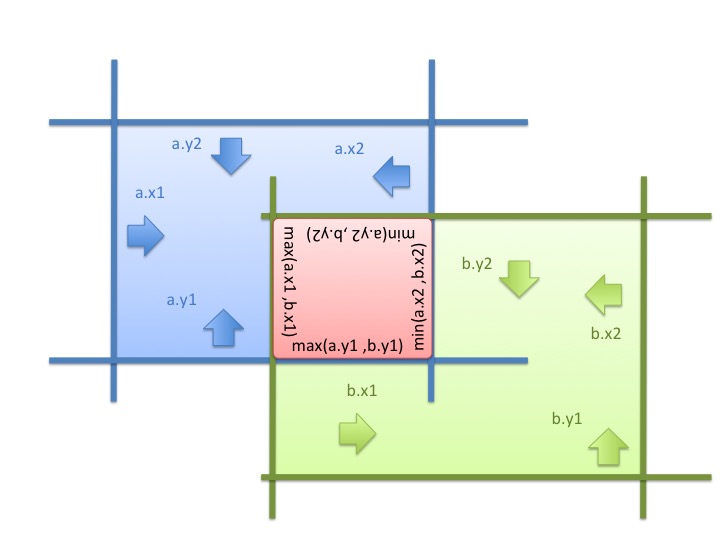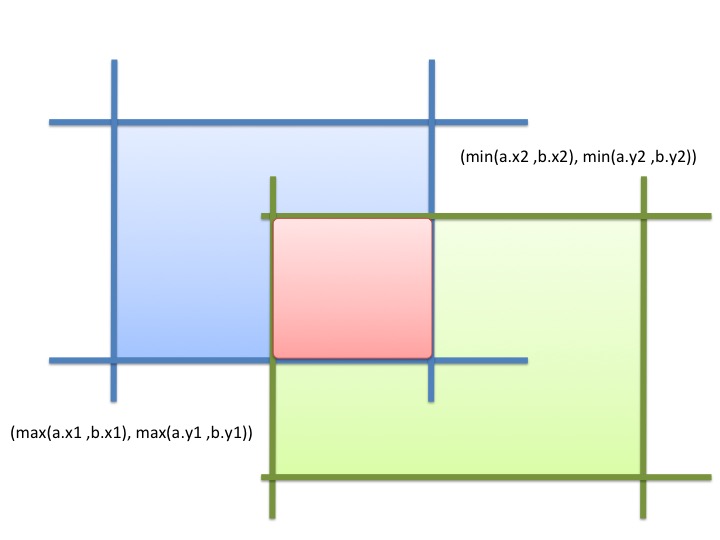1対1の当たり判定、長方形の交差問題

ごく簡単な条件で判定できます。
max(a.y1, b.y1) ≤ min(a.y2, b.y2)
def has_intersect(a, b): return max(a.x1, b.x1) <= min(a.x2, b.x2) \ and max(a.y1, b.y1) <= min(a.y2, b.y2)
こんな感じで使います。
>>> has_intersect(Rectangle(0,0,10,10), Rectangle(5,5,15,15)) True >>> >>> has_intersect(Rectangle(0,0,10,10), Rectangle(15,15,25,25)) False >>>
長方形 Rectangle クラス
class Rectangle(object): def __init__(self, x1, y1, x2, y2): if not is_rectangle(x1, y1, x2, y2): raise ValueError("Coordinates are invalid.\n" + "Rectangle" + str((x1, y1, x2, y2))) self.x1 = x1 self.y1 = y1 self.x2 = x2 self.y2 = y2 def is_rectangle(x1, y1, x2, y2): return x1 <= x2 and y1 <= y2
なんでこんなので判定できるの?式の意味は?
条件式は、交差した長方形の領域が存在するかどうかを判定しています。
Step 1. 1 つの長方形で囲まれた領域
2 点 (x1, y1), (x2, y2) で囲まれた長方形を、点で囲まれた長方形ではなく

ポイント1 長方形の表現
長方形は x1, y1, x2, y2 の 4 つの領域で囲まていると考えることにします。
右方向の領域: x1 ≤ x
上方向の領域: y1 ≤ y
左方向の領域: x ≤ x2
下方向の領域: y ≤ y2

ポイント2 長方形の条件
x1, y1, x2, y2 の 4 つの領域が重複している箇所があれば
長方形であると言える。
条件を次のように考えることができます。
y1 ≤ y2
def is_rectangle(x1, y1, x2, y2): return x1 <= x2 and y1 <= y2
Step 2. 2 つの長方形で囲まれた領域

考え方は同じです。上下左右方向の4つの領域が
4つ同時に重なる箇所があるかないかを判定ます。
あれば交差しているし、なければ交差していません。
Step 1 では領域を表現する線は各方向に 1 つだけでした。
ここでは 2 つ存在しています。
交差する領域を探していきます。
右方向の交差する領域: a.x1, b.x1 の大きい方から右方向
上方向の交差する領域: a.y1, b.y1 の大きい方から上方向
左方向の交差する領域: a.x2, b.x2 の小さい方から左方向
下方向の交差する領域: a.y2, b.y2 の小さい方から下方向
右方向の交差する領域: max(a.x1, b.x1) ≤ x
上方向の交差する領域: max(a.y1, b.y1) ≤ y
左方向の交差する領域: x ≤ min(a.x2, b.x2)
下方向の交差する領域: y ≤ min(a.y2, b.y2)

これで4方向の領域がそれぞれ取得できました。あとは Step1 で確認した長方形の条件を当てはめて、交差しているかを確認するだけです。
max(a.y1, b.y1) ≤ min(a.y2, b.y2)
def has_intersect(a, b): return max(a.x1, b.x1) <= min(a.x2, b.x2) \ and max(a.y1, b.y1) <= min(a.y2, b.y2)
当てはめてと言われても「え?」ってなると思いますが、こんな感じで is_rectangle 関数を使うと Step1 の条件を当てはめているのがわかります。
def has_intersect(a, b): return is_rectangle(intersect_bound(a, b)) def intersect_bound(a, b): """4方向の各領域の積集合を求める関数""" x1 = max(a.x1, b.x1) y1 = max(a.y1, b.y1) x2 = min(a.x2, b.x2) y2 = min(a.y2, b.y2) return x1, y1, x2, y2
交差する領域

このとき、これは交差する長方形の領域を表現します。
def intersect(a, b): return Rectangle(max(a.x1, b.x1), max(a.y1, b.y1), min(a.x2, b.x2), min(a.y2, b.y2))
あるいはこんな感じで
def intersect(a, b): return Rectangle(intersect_bound(a, b))
>>> intersect(Rectangle(0,0,10,10), Rectangle(5,5,15,15)) Rectangle(5, 5, 10, 10) >>>
交差していなければ、None ではなく例外を投げる。
『Effective Python』Item 14: Noneを返すよりも例外を発生させよう
>>> intersect(Rectangle(0,0,10,10), Rectangle(15,15,25,25)) Traceback (most recent call last): File "<stdin>", line 1, in <module> File "<stdin>", line 22, in __and__ File "<stdin>", line 6, in __init__ ValueError: Coordinates are invalid. Rectangle(15, 15, 10, 10) >>>
◯ 実装まとめ
def has_intersect(a, b): return is_rectangle(intersect_bound(a, b)) def is_rectangle(x1, y1, x2, y2): return x1 <= x2 and y1 <= y2 def intersect(a, b): return Rectangle(intersect_bound(a, b)) def intersect_bound(a, b): x1 = max(a.x1, b.x1) y1 = max(a.y1, b.y1) x2 = min(a.x2, b.x2) y2 = min(a.y2, b.y2) return x1, y1, x2, y2 class Rectangle(object): def __init__(self, x1, y1, x2, y2): if not is_rectangle(x1, y1, x2, y2): raise ValueError("Coordinates are invalid.\n" + "Rectangle" + str((x1, y1, x2, y2))) self.x1 = x1 self.y1 = y1 self.x2 = x2 self.y2 = y2 def __repr__(self): return ("Rectangle" + str((self.x1, self.y1, self.x2, self.y2)))